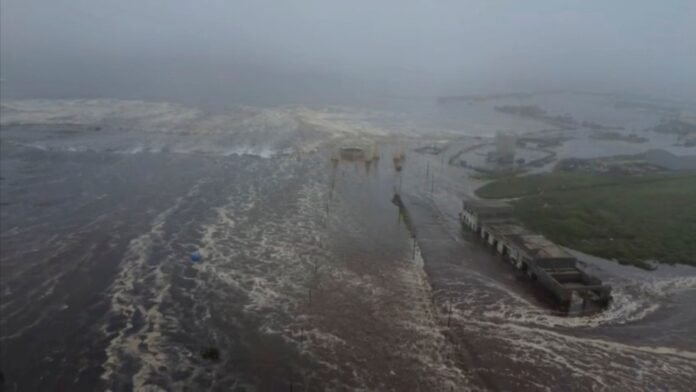Seismological Overview
Russia’s Massive Undersea Earthquake and the Pacific Tsunami Alert
On July 30, 2025, a truly massive magnitude 8.8 earthquake struck off Russia’s Kamchatka Peninsula, centered roughly 84 miles (≈ 140 km) east of Petropavlovsk‑Kamchatsky, at a shallow depth of about 19–20 km. According to the U.S. Geological Survey (USGS), this quake ranks among the strongest ever recorded globally, and the largest in Russia since 1952.
The region around Kamchatka lies along the Kuril–Kamchatka trench, where the Pacific Plate subducts beneath the Okhotsk Plate. This zone regularly spawns megathrust earthquakes. Historically, earthquakes of magnitude 9.0 or higher in this area, such as in 1952, 1841, and 1737, have generated enormous tsunamis, sometimes devastating Hawaii and other Pacific regions.
This 2025 quake triggered a dramatic ripple of seismic alerts, spanning initial tsunami warnings across Japan, Alaska, and the U.S. West Coast, including Hawaii and California, before many were later downgraded as the threat evolved.
Early Response: Warnings, Watches, and Precautions
Russia & Kamchatka
Immediately after the quake, Russia’s Ministry of Emergency Situations issued tsunami warnings for coastal communities of Kamchatka, warning of possible wave heights up to 60 cm along northern coasts, 40 cm near Ust‑Kamchatka, and no more than 15 cm at Petropavlovsk‑Kamchatsky.https://www.thesun.co.uk/
Within the first hour, local reports confirmed waves up to 4 m (≈13 ft) inundating parts of southern Kamchatka, prompting evacuations in low‑lying zones.https://www.bbc.com/news/live/c3r4x9yrrg4t
Hawaii
The PTWC issued a tsunami warning for Hawaii, forecasting the first waves around 7:17 p.m. HST and estimated heights up to 3 m (≈10 ft) or more.
Governor Josh Green urged residents in low‑lying and coastal areas to evacuate; sirens blared across Honolulu and other communities, and emergency shelters were activated. O‘ahu’s Hanalei Bay and Maui’s Kahului saw early wave activity.
Although initial projections feared a high-impact tsunami, moderate wave amplitudes were observed—4 ft (≈1.2 m) at Haleiwa, Maui, and multiple locations across O‘ahu, Maui, and Hilo.
Oprah Winfrey reportedly opened her private road in Maui to ease residential evacuations—an act coordinated with local authorities to facilitate traffic flow for over 50 cars at a time.
U.S. West Coast and Alaska
Northern California—from Crescent City up to the Oregon border—was placed on tsunami watch/advisory, with Crescent City particularly at risk due to its known vulnerability. Waves reaching around 4 ft were recorded in California’s Arena Cove.
Meanwhile, parts of Alaska, particularly the Aleutian Islands, were also under tsunami alerts, though coastal impacts there remained limited.
Japan issued evacuation advisories for nearly 2 million people in coastal areas of Hokkaido and elsewhere. Early, smaller waves (around 30 cm) reached northern Japan. The Fukushima nuclear plant was briefly evacuated as a precaution, although no anomalies were reported.
Tsunami Arrival and Impacts
Kamchatka Peninsula
First waves arrived within minutes of the quake, with heights of up to 4 m, causing flooding in coastal villages and prompting evacuation orders. Although structural damage was initially reported, comprehensive assessments are ongoing.
Hawaii
Residents reported mild-to-moderate impacts: waves up to 4 ft at Haleiwa, Kahului, and Pearl Harbor, arriving approximately every 12 minutes. Water levels surged briefly, but extensive damage was avoided. Minor flooding, some coastal erosion, and disruptions were noted, but overall damage appeared limited.
Evacuation orders were gradually lifted as waves subsided; officials repeatedly warned of possible additional surges and dangerous currents, urging continued vigilance until all threat confirmed resolved.
California & U.S. Mainland
California saw 4‑ft waves at Arena Cove and strong currents along harbors and marinas. Campgrounds, waterfront towns, and some boats were evacuated. While fears remained for places like Crescent City, no substantial coastal damage or casualties were reported.
Alaska experienced minor wave action but no major incidents were noted.
Historical Perspective: Kamchatka Tsunamis and Hawaii
This seismic event echoed past devastating tsunamis born in the same region:
- In 1952, a magnitude 9.0 quake off Kamchatka triggered an 18 m tsunami that struck Hawaii, causing property damage though few casualties were confirmed.
- Historical quakes in 1841 (≈9.0) and even as early as 1737 generated massive tsunamis up to 15 m, reaching as far as Hilo with waves around 4.6 m.
These events underscore the global significance of megathrust quakes in the Pacific “Ring of Fire.” The 2025 event was among the strongest in recorded history—ranked within the top ten globally—and was the largest in Kamchatka since 1952.
Science of Tsunami Generation and Alert Protocols
How Tsunamis Arise
Tsunamis result from vertical displacement of the seafloor during powerful undersea earthquakes—often megathrust events in subduction zones. Depth, magnitude, and slip area determine the scale of displacement and hence tsunami potential.
Alert Systems: Watches, Advisories, Warnings
- Tsunami Watch: A potential tsunami is possible based on seismic data; no immediate evacuation unless escalated.
- Tsunami Advisory: Strong currents or minor flooding likely; people should stay away from shorelines.
- Tsunami Warning: Significant coastal flooding imminent; evacuation required.
In the July event, Hawaii initially received a warning while later alerts were downgraded or lifted after data confirmed wave strength would remain moderate.
Human and Government Responses
Emergency Coordination
Local, state, and federal agencies across the Pacific worked in concert. Hawaii emergency services activated sirens, opened shelters, and coordinated evacuations. Even private infrastructure—such as Oprah Winfrey’s private road in Maui—was utilized to aid evacuations, showcasing community-level solidarity.
Japan mobilized coastal evacuations including nuclear facility precautions; Alaska and West Coast jurisdictions issued their own advisories and precautionary guidance.
Public Reaction
Residents received emergency alerts in real time. In one dramatic moment, a BBC live interview in Hawaii was abruptly cut short when sirens sounded and the guest read out an evacuation message live on-air. Despite initial panic, most coastal evacuations were orderly and successful.
Flight cancellations, road congestion, and communication alerts disrupted many routines, but proactive warnings helped avert tragedy.
Aftermath and Ongoing Threat
- By midday July 30, authorities confirmed tsunami warnings and watches had largely been lifted as wave activity proved moderate. Alaska, California, and Hawaii transitioned back to advisory or normal status as conditions stabilized.
- No fatalities were reported; property damage appeared limited to minor flooding, erosion, and disruptions to waterfront infrastructure.
- Seismic aftershocks—some exceeding magnitude 6.5—continued to be monitored. Emergency agencies remained ready in case further displacement generated additional waves.
Lessons Learned
- Preparedness matters: Recent infrastructure resilience and warning systems prevented chaos despite the quake’s enormity. Past events have informed best practices in Pacific coastal communities.
- Rapid alert systems: Within minutes of seismic detection, tsunami watches and warnings were issued across multiple countries, minimizing risk despite evolving forecasts.
- Public cooperation: Residents followed evacuation orders and stayed informed—evidenced by orderly evacuations in Hawaii and Japan.
- Importance of geography: Distance, bathymetry, and coastline shape affected wave amplitude. Hawaii experienced modest waves, while more exposed regions like Kamchatka saw higher impacts.
- Awareness of aftershocks: Continued seismic activity remains dangerous and may trigger further tsunamis—necessitating maintained alert status until the threat conclusively subsides.



